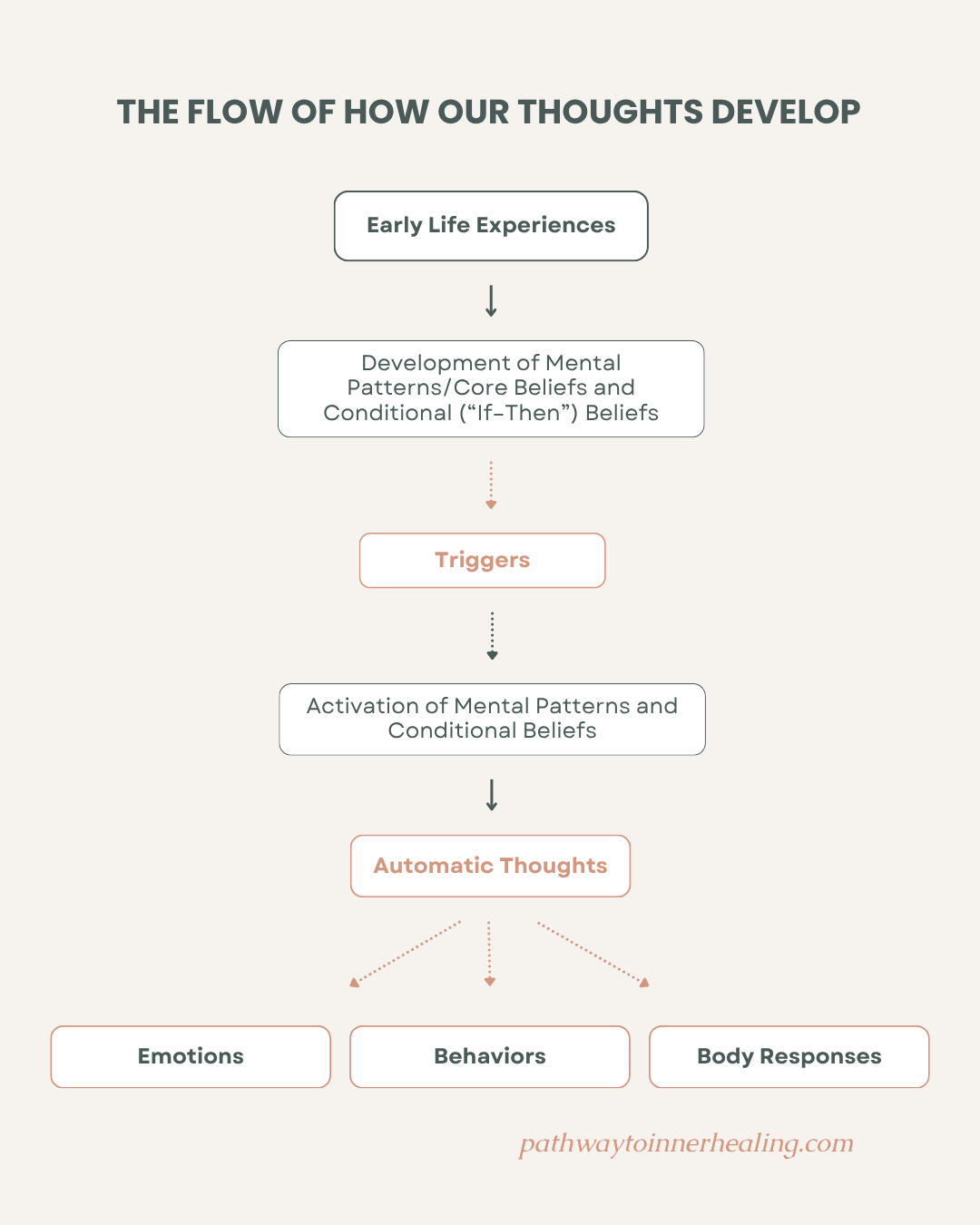How Early Life Experiences Shape Our Thoughts and Emotions
Have you ever found yourself reacting strongly to something small — like feeling anxious after getting feedback at work, or guilty for taking a break? You might know it’s not a “big deal,” but your body and mind respond as if it is.
That reaction often has deep roots. It’s not random — it’s connected to the way your mind learned to protect you growing up.
Dr. John Ludgate, a clinical psychologist and expert in Cognitive Behavioral Therapy (CBT), created a helpful model to explain how our early life experiences shape the way we think, feel, and react as adults. Understanding this model can help you slow down, make sense of your emotions, and start healing from old patterns that no longer serve you.
Step-by-Step Breakdown
1. Early Life Experiences
These are the building blocks of how we see ourselves and the world. They come from how we were raised, the messages we heard growing up, and the environment we lived in.
For example:
If your family valued hard work above rest, you may have learned that “being busy means being worthy.”
If you grew up in a household where emotions weren’t discussed, you might have learned that “feeling sad or angry is not okay.”
These lessons become the foundation for how we think and respond later in life.
2. Development of Mental Patterns and Core Beliefs
Over time, those early lessons form mental patterns — the stories and rules we carry into adulthood.
They sound like:
“I have to be perfect to be loved.”
“If I make a mistake, I’ll disappoint everyone.”
“I can’t ask for help — I should handle things on my own.”
These beliefs once helped us feel safe or accepted, but as adults, they can become limiting and exhausting.
Conditional beliefs are the “if–then” rules your mind uses to try to keep you safe:
“If I keep everyone happy, then I’ll be accepted.”
“If I don’t speak up, then no one will get upset with me.”
3. Triggers
A trigger is anything that stirs up those old patterns. It could be criticism at work, a disagreement with your partner, or even seeing someone else succeed.
These triggers make our old beliefs “light up,” even when the present situation isn’t the same as the past.
4. Activation of Mental Patterns
Once triggered, your mind goes into autopilot. Those old beliefs — like “I’m not enough” or “I have to fix this” — take over your thoughts before you realize it.
This step happens fast and often subconsciously, which is why therapy focuses on slowing things down so you can notice what’s really happening.
5. Automatic Thoughts
These are the quick, reflex-like thoughts that pop up in response to a situation. They’re often negative, self-critical, and deeply tied to our old patterns.
Examples:
“I always mess things up.”
“They must be disappointed in me.”
“I shouldn’t have said that.”
The more we believe these thoughts, the stronger they become — like grooves your brain keeps traveling down.
6. Emotions, Behaviors, and Body Responses
Our thoughts shape how we feel, act, and even how our body reacts.
Emotions: Anxiety, shame, frustration, guilt
Behaviors: Overworking, people-pleasing, shutting down, withdrawing
Body Responses: Tight chest, racing heart, exhaustion, headaches
When you’re living in this cycle often, it can start to feel like you’re constantly “on edge” or never doing enough — even when you are.
💬 Why This Model Matters
This framework helps you see that your reactions aren’t random or “crazy.” They make sense given what your mind learned long ago to keep you safe.
But the good news? You can learn new patterns.
Therapy helps you identify the old rules that no longer serve you and replace them with beliefs that support your growth, peace, and balance.
Instead of “I have to do everything perfectly,” you can begin to believe, “I’m doing my best, and that’s enough.”
Gentle Ways to Begin Shifting These Patterns
If you recognize yourself in this cycle, here are some small steps to start creating change:
Pause and notice: When you feel activated, take a breath and name what’s happening. (“I feel like I’m not enough right now.”)
Challenge the thought: Ask, “Is this true — or is this my old pattern talking?”
Practice compassion: Speak to yourself the way you would to a close friend.
Seek support: You don’t have to unpack this alone. A therapist can help you identify where these beliefs began and how to rewrite them.
You’re Not Broken
Your reactions are learned responses, not flaws. You’re responding to years of conditioning. So, remember, they’re old survival skills that once protected you. Now, it’s time to replace them with patterns that let you feel calm, confident, and connected.
If you’re ready to better understand your emotions, ease anxiety, and build a healthier relationship with yourself, therapy can help you get there.
Schedule an appointment or share this post with someone who might need a reminder that healing is possible — one small step at a time.
Disclaimer
This post is for informational and educational purposes only and should not replace professional therapy or medical advice.
